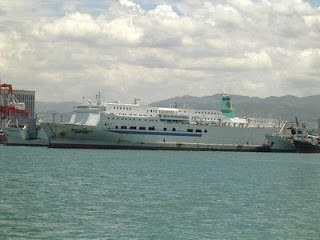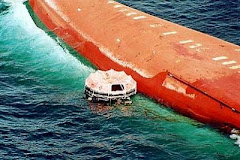
Disaster
The MV Princess of the Stars, flagship of the Sulpicio Lines fleet, left the port of Manila on June 20, 2008 on its way to Cebu City. The number of passengers is variously reported between 700 and 800.The ferry sent a distress signal at midday on June 21 when its engines allegedly stalled in rough seas near Sibuyan Island. San Fernando mayor Nanette Tansingco sent a speedboat and confirmed that the ferry had a hole in the hull, was partially submerged and that several bodies had been found nearby. Later reports revealed that the hole in the hull was actually the ship's bow thruster.

Location of the storm and the Princess of the Stars when the ship lost radio contact at 11 am June 21, 2008.As of June 23, four bodies were recovered by the Philippine Coast Guard and the Philippine Navy.According to the Coast Guard, the ferry's manifest recorded 702 passengers including 50 children as well as 100 crew. The civil defense office said the ship carried 626 passengers and 121 crew members. Three Navy vessels were dispatched but one had to abort its mission due to "gigantic waves, pounding rain, and gusty winds," said Lieutenant Colonel Edgard Arevalo, spokesman of the Philippine Navy.
A rescue ship reached the MV Princess of the Stars, more than 24 hours after it lost radio contact at 12:30 PST (04:30 GMT) on Saturday.Philippine Coast Guard spokesman Lt. Senior Grade Arman Balilo, however, lamented: "They haven't seen anyone. They're scouring the area. They're studying the direction of the waves to determine where survivors may have drifted."
Xinhua News Agency reported that 4 survivors witnessed "that the captain of the ship ordered the abandoning of the ship at noon Saturday, but many passengers did not even wear life vests when the ship capsized." Four survivors told GMA News that "the ship did not malfunction, but only slowed down its speed as it encountered big waves off the coast of Romblon." One saw many people jump, but "the waves were so big and the rains so strong that few of them could have possibly survived; the crew were so busy saving themselves that they did not care to help the passengers to wear safety vests, and that some of the passengers passed out while children and the elderly failed to wear life vests because they could no longer move when the ship was turning upside down."
Tansingco confirmed that 4 aboard died and hundreds of passengers were still missing. Dozens of people trooped to the offices of owner Sulpicio Lines in Cebu and Manila North Harbor. The victims' families accused Sulpicio Lines and the Philippine Coast Guard of allowing the ship to set sail despite the bad weather. They further blamed Sulpicio for not personally informing them about the tragedy, the details of the accident, and the condition of the ship plus its passengers. Sulpicio Lines's counsel stated that "the ship never received advice from Coast Guard, while Metro Manila was still under public storm signal No. 1 when the ship left the port." Furthermore, BBC quoted President Gloria Macapagal-Arroyo as saying, "Why did you allow it to sail and why was there no ample warning? I want answers."
Sulpicio admitted that 860 were on board as the ferry capsized: "There were 751 manifested passengers and 111 crew members on board the capsized vessel." The Maritime Industry Authority (Marina) suspended all sea travel operations of the Sulpicio. Sulpicio lines released the names of 32 survivors with the complete passenger manifest and crew list uploaded on their website.
A week after the ferry disaster, more than 100 passengers have been confirmed dead, with 500 still missing. The ship is also carrying the pesticide, endosulfan. Some 60+ passengers were found within the first week.
Survivors and recovered bodies
Meanwhile, Claveria, Masbate Mayor Eduardo Andueza reported 350 corpses recovered while 40 people were rescued off the coast of Burias Island, Masbate on Monday. The bodies however could not have only come from the MV Princess of the Stars but also from other vessels that capsized. Some of the 40 survivors said they came from cargo vessel MV Lake Paway, which departed from Mindanao but later sank at sea.
Twenty five survivors from the ferry were transported from Quezon province to the headquarters of the Philippine National Red Cross in Intramuros, Manila. Senator and Red Cross chairman Richard Gordon stated that the survivors were given food, clothing and medical assistance. A Red Cross official also reported that some went home to their families in Manila.
The Philippine Coast Guard on June 24, 2008 reported that it accounted for only 115 (48 survivors confirmed, 67 others confirmed dead, 747 missing) of the 862 passengers and crew of the MV Princess of the Stars. Divers, however said that 15 bodies were found inside the ship's dining area and 2 others in the bridge.
Philippines Navy spokesman Lt. Col. Edgard Arevalo said the ship's interior was too dark: "Most of the bodies were floating inside. They were trapped when the seven-story ship suddenly tilted and capsized. The reports we're getting are that many bodies have been found."
Navy divers and rescuers found bodies, wearing life jackets, trapped in air pockets, but no survivors inside the wreck when they entered the upturned hulk of the ferry. The corpses turned white, floating head up inside the mass grave below the waves. A helicopter from U.S. military ship, the USNS Stockham, found 12 corpses floating near Masbate island, but it was not clear if they were from the Princess of the Stars. Sulpicio lines said "it would pay families of the dead 200,000 pesos ($4,500) each and also give survivors financial assistance." VP Noli de Castro presided over the first meeting of the newly created "Task Force Princess Stars."
On June 27, 2008 recovery efforts were ceased due to the discovery that 10,000 kilos of the dangerous pesticide endosulfan were on board. The government is considering filing charges as it is illegal to transport dangerous goods on passenger vessels in the Philippines.
BMI final report
The 5-member Philippines Board of Marine Inquiry, in its 65-page report dated August 25, 2008 (submitted to the Maritime Industry Authority or Marina), found Sulpicio Lines and its captain liable for the MV Princess of the Stars June 21 maritime tragedy. The BMI recommended that Marina “consider the suspension of the Certificate of Public Convenience (CPC) of Sulpicio Lines in accordance with existing laws, rules and regulations (and its criminal liability for the sinking." The final report blamed human error, and ruled that the ship's missing and presumed dead captain, Florencio Marimon, "miscalculated" the risk of continuing the trip to Cebu while the storm raged: "There was a failure of the master to exercise extraordinary diligence and good seamanship thereby committing an error of judgment.The immediate cause of the capsizing of MV Princess of the Stars was the failure of the Master to exercise extraordinary diligence and good seamanship thereby committing an error of judgment that brought MV Princess of the Stars in harm's way into the eye of Typhoon Fengshen (Frank). It is found negligent for its failure to exercise its duty in ensuring that they transport passengers and cargo safely to (their) destination.”

Sulpicio said 52 survived the tragedy and 312 bodies were recovered of 825 passengers listed. The rest were declared missing and presumed dead. Sulpicio may appeal within 30 days, the Board's recommendation to the Maritime Industry Authority (Philippines) and the Department of Transportation. Meanwhile, cargoes of 5 toxic pesticides and other poisonous substances are still on board the ferry and will be refloated on September.Sulpicio Lines, the 2nd largest cargo carrier in the Philippines, accounts for 40% of all cargo movement across the country.
Raising of the stars
The Philippine government and the Sulpicio Lines have decided to 'refloat' the sunken MV Princess of the Stars. The say, this would help in retrieving the hundreds of bodies still trapped inside the vessel, as well as easing the retrieval of the toxic cargo inside the ship. Vice President Noli De Castro says, this would probably take a month before the ship is refloated.

This seems an amazing, yet dangerous task. Amazing, because it's probably one of the first in the world for a doomed passenger ship to be refloated again. It would take really big vessels and equipment for this to happen. But there are also risks since no one knows the exact spot where the toxic endosulfan is located.
As of press time, more than 700 passengers and crew are still unaccounted for.






































